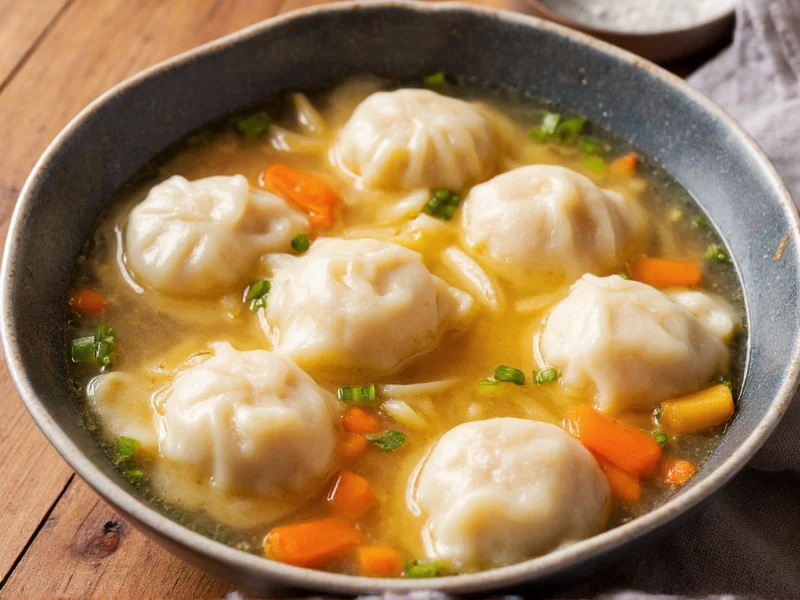These delicate parcels represent one of Chinese cuisine's most celebrated culinary innovations. Unlike regular dumplings, chicken soup dumplings contain a pocket of flavorful broth that transforms during cooking. The technique dates back to 19th century Shanghai, where chefs discovered that embedding solidified chicken aspic into dumpling fillings would liquefy during steaming, creating the "soup" effect.
The Science Behind the Soup Center
Understanding the physics of chicken soup dumplings explains why they're so challenging to perfect. The key lies in gelatinized broth - chicken stock cooled until it becomes jelly-like. When minced chicken, seasonings, and this aspic combine inside the thin wrapper, the heat of steaming melts the aspic back into liquid form. This creates the signature burst of hot, flavorful soup when you take your first bite.
Essential Ingredients for Authentic Flavor
Creating genuine chicken soup dumplings requires precise ingredients:
| Ingredient | Function | Substitution Options |
|---|---|---|
| Homemade chicken aspic | Creates the soup center | Store-bought consommé (less ideal) |
| Minced chicken thigh | Provides tender filling | Chicken breast (less juicy) |
| Thin wheat wrappers | Holds the liquid without breaking | Homemade wrappers preferred |
| Ginger and Shaoxing wine | Enhances flavor profile | Dry sherry (for wine) |
Step-by-Step Preparation Guide
Mastering how to make chicken soup dumplings requires patience and practice. Follow these steps for success:
- Prepare the aspic: Simmer chicken bones, ginger, and scallions for 4 hours. Strain and chill until solidified.
- Make the filling: Combine minced chicken, finely chopped aspic, ginger, Shaoxing wine, and seasonings.
- Wrap carefully: Place 1½ teaspoons filling in center of wrapper. Pleat edges with 18-22 folds, leaving small opening at top.
- Steam properly: Cook in bamboo steamer for 8-10 minutes over boiling water. Never overcrowd the steamer.
Avoiding Common Mistakes
Many home cooks struggle with chicken soup dumplings breaking during cooking. Prevent this by:
- Using wrappers at room temperature (cold wrappers crack)
- Ensuring filling remains chilled until wrapping
- Not overfilling (1½ tsp maximum per dumpling)
- Sealing tightly while leaving small steam vent
Regional Variations Across Asia
While Shanghai-style authentic chicken soup dumpling recipe remains most famous, variations exist throughout Asia:
- Taiwanese versions often include crab roe for added luxury
- Singaporean adaptations incorporate local spices like star anise
- Japanese shoronpo uses thinner wrappers and pork-based broth
- Modern interpretations feature truffle oil or seasonal ingredients
Serving Traditions and Etiquette
Enjoying chicken soup dumplings properly enhances the experience. Traditional serving includes:
- Placing dumpling on spoon, adding ginger slivers and black vinegar
- Biting small opening to release steam before drinking broth
- Consuming immediately while hot (they harden as they cool)
- Never dipping whole dumpling - this causes breakage
Storage and Reheating Techniques
Proper storage maintains quality for leftover chicken soup dumplings:
- Uncooked: Freeze on parchment-lined tray, then transfer to container (3 months)
- Cooked: Refrigerate up to 2 days (not recommended as quality suffers)
- Reheating: Steam frozen dumplings 2-3 minutes longer than fresh
- Never microwave - causes uneven heating and wrapper damage
Perfect Pairings for Complete Meal Experience
Complement your homemade chicken soup dumplings with these traditional accompaniments:
- Light green tea (helps cut richness)
- Simple cucumber salad with sesame oil
- Steamed jasmine rice for heartier meal
- Chilled Shaoxing wine for authentic experience
Frequently Asked Questions
Can I make chicken soup dumplings without aspic?
No authentic version exists without aspic, as it's essential for creating the soup center. The gelatinized broth transforms during cooking to create the signature liquid filling. Some modern recipes use broth cubes, but these lack the proper gel structure and result in dry dumplings.
Why do my chicken soup dumplings keep bursting?
Bursting typically occurs from overfilling, improper sealing, or using warm filling. Keep filling chilled, use no more than 1½ teaspoons per dumpling, and ensure tight pleating with a small steam vent. Cold wrappers also prevent tearing during folding.
How can I tell when chicken soup dumplings are perfectly cooked?
Perfectly cooked dumplings have translucent wrappers showing the filling's color, feel slightly firm to touch, and release aromatic steam. The cooking time is typically 8-10 minutes - any longer causes the wrappers to toughen and potentially break. Watch for the broth inside becoming visible through the wrapper.
What's the difference between chicken soup dumplings and regular dumplings?
Chicken soup dumplings contain gelatinized broth that melts during cooking, creating a soup center, while regular dumplings have solid fillings. Soup dumplings use thinner wrappers, require specialized pleating techniques, and are always steamed rather than boiled or pan-fried. The eating experience differs significantly as soup dumplings require careful handling to enjoy the liquid center.
Can I freeze uncooked chicken soup dumplings?
Yes, freezing uncooked dumplings is the best preservation method. Arrange them on a parchment-lined tray without touching, freeze until solid (about 2 hours), then transfer to airtight containers. They'll keep for up to 3 months. Cook directly from frozen, adding 2-3 minutes to steaming time. Never thaw before cooking.











 浙公网安备
33010002000092号
浙公网安备
33010002000092号 浙B2-20120091-4
浙B2-20120091-4